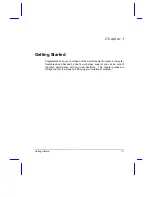
User’s Manual
Glossary-9
Glossary
input:
The data or instructions you provide to a computer, communication
device or other peripheral device from the keyboard or external or
internal storage devices. The data sent (or output) by the sending
computer is input for the receiving computer.
instruction:
Statements or commands that specify how to perform a
particular task.
interface:
1) Hardware and/or software components of a system used
specifically to connect one system or device to another.
2) To physically connect one system or device to another to
exchange information.
3) The point of contact between user, the computer, and the
program, for example, the keyboard or a menu.
interrupt request:
A signal that gives a component access to the
processor.
J
jumper:
A small clip or wire that allows you to change the hardware
characteristics by electrically connecting two points of a circuit.
K
K:
Taken from the Greek word kilo, meaning 1000; often used as equivalent
to 1024, or 2 raised to the 10th power. See also byte and kilobyte.
KB:
See
kilobyte.
keyboard:
An input device containing switches that are activated by
manually pressing marked keys. Each keystroke activates a switch
that transmits a specific code to the computer. For each key, the
transmitted code is, in turn, representative of the (ASCII) character
marked on the key.
kilobyte (KB):
A unit of data storage equal to 1024 bytes.
See also
byte
and megabit.
L
level 2 cache:
See cache.
Light Emitting Diode (LED):
A semiconductor device that emits light when
a current is applied.
Liquid Crystal Display (LCD):
Liquid crystal sealed between two sheets of
glass coated with transparent conducting material. The viewing-side
coating is etched into character forming segments with leads that
extend to the edge of the glass. Applying a voltage between the
glass sheets darkens the liquid crystal to provide contrast to lighted
portions of the display.










































